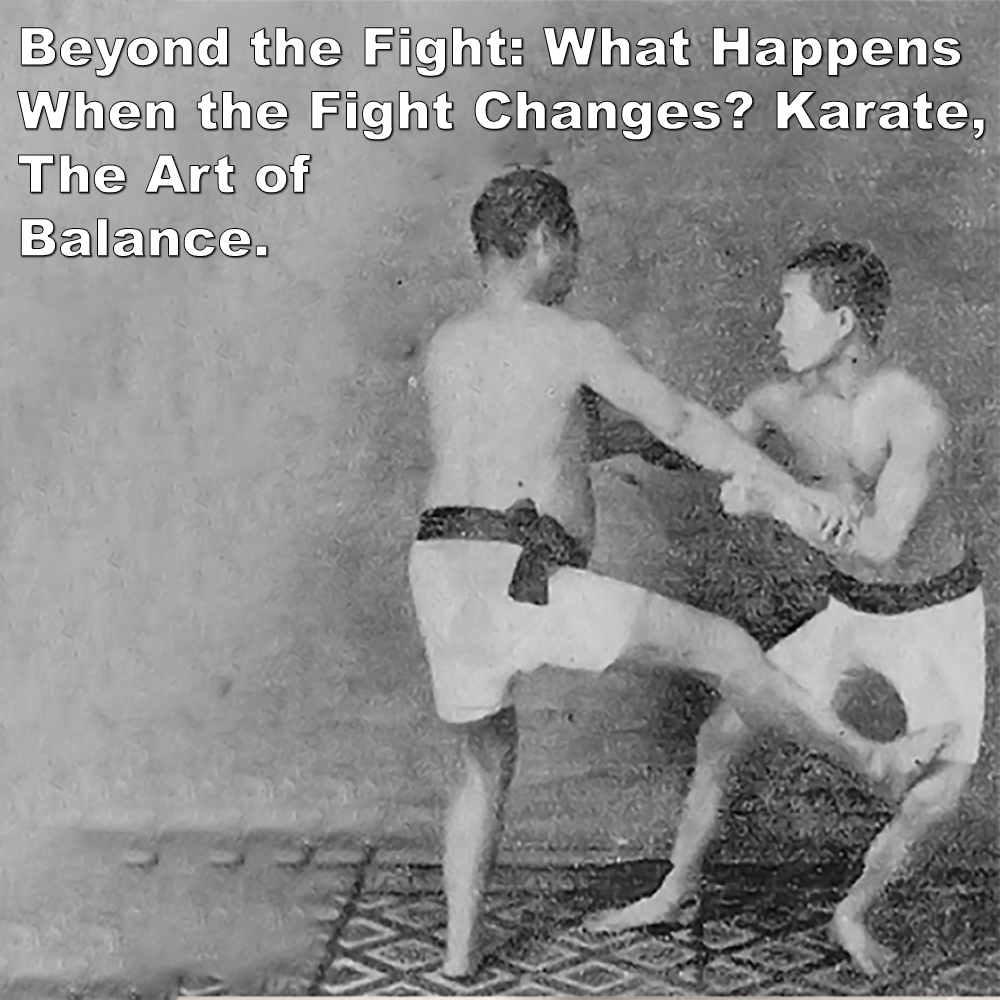
(Approx 2 minute 55 second read)
Recently we had two students who were big guys they hadn’t been training very long. Occasionally, we have free drills where anything goes. Now, as they were inexperienced, their contact was heavily restricted.
.
It was interesting to watch as the exchange began to heat up, as invariably it does, and without any instruction, they just started grabbing each other.
.
So what, you might ask.
.
Well, much of karate today, when practiced with a partner, is performed at a distance – a safe posture. But what happens when the distance you are accustomed to vanishes, and you find yourself in unfamiliar territory? Then what?
.
In a recent article, I used an image of four martial artists all doing the same kicking technique to the leg, sometimes called an oblique kick. Only one of those images showed someone grabbing the opponent while performing the kick.
.
It was the oldest image of the group, featuring the great karate master Choki Motobu, who was extremely well-known at the time as an accomplished fighter.
.
There are those who believe only Judo, Jiu-Jitsu, MMA, or BJJ can provide grappling and throws, and often people will seek out instructors in these methods as an addition to their training. However, many of these effective fighting techniques – throws, trips, locks, sweeps, takedowns, strangles, chokes…all of these can be found in karate, if you take the time to look.
.
Someone said to me the other day that we have no proof of this because everything during WWII was destroyed on Okinawa. Much was lost, there is no denying that, including many lives, but there are documents that do exist. There are translations from the Bubishi, from Itosu, Funakoshi, Motobu, Mabuni, to name just a few. There are oral traditions passed from one teacher to the next. Of course, some of these may be embellished, but nevertheless, they give us an idea of the depth that karate has to offer.
.
Karate was never meant for a competition – one-on-one, karate-vs-karate contests. Why? Because techniques that are effective for ‘kumite’ or sparring in the dojo, and competitive matches are not necessarily sensible choices for self-protection.
.
Someone also said to me that MMA is the most effective for self-defense and it takes less time to learn. It should be pretty obvious to everyone that MMA is indeed quite effective.
.
From day one at an MMA gym, you will be taught how to do harm to others and how to avoid being harmed yourself. All your time will be devoted to conditioning and drilling things that will help you become a proficient fighter. To become reasonably proficient really doesn’t take long either – training at a quality gym will place someone light years ahead of an untrained individual.
.
However, any martial art should give you much more than the ability to fight in a gym. Is it such a bad thing that karate has become so much more?
.
If all we did was learn to fight, what happens as we age, if we’re injured, or if we have friends and family with us? What if we are in a car, a store, or at a wedding?
.
Recently, I had a young man high on LSD banging on my front door, causing a ruckus in the street. Should I have fought him, taken him to the pavement, and administered a ground-and-pound?
.
Of course not. I’m not saying that anything other than karate would have fixed this situation, but if all you know is how to fight – and to fight first – things could have taken a bad turn.
.
Karate today helps to build confidence, it fosters a combination of self-respect and self-awareness so that you don’t present yourself as a victim.
.
Other disciplines can certainly offer similar benefits, but the masters of old were telling us this long before it all became popular today.
.
I am an advocate of practical, pragmatic karate, but I believe that it has more to offer than just fighting. Karate was created for civilian self-defense and self-protection, and its precepts and principles are just as important today, ensuring karate remains as relevant now as it was when it was created.
.
Written by AC.
.
